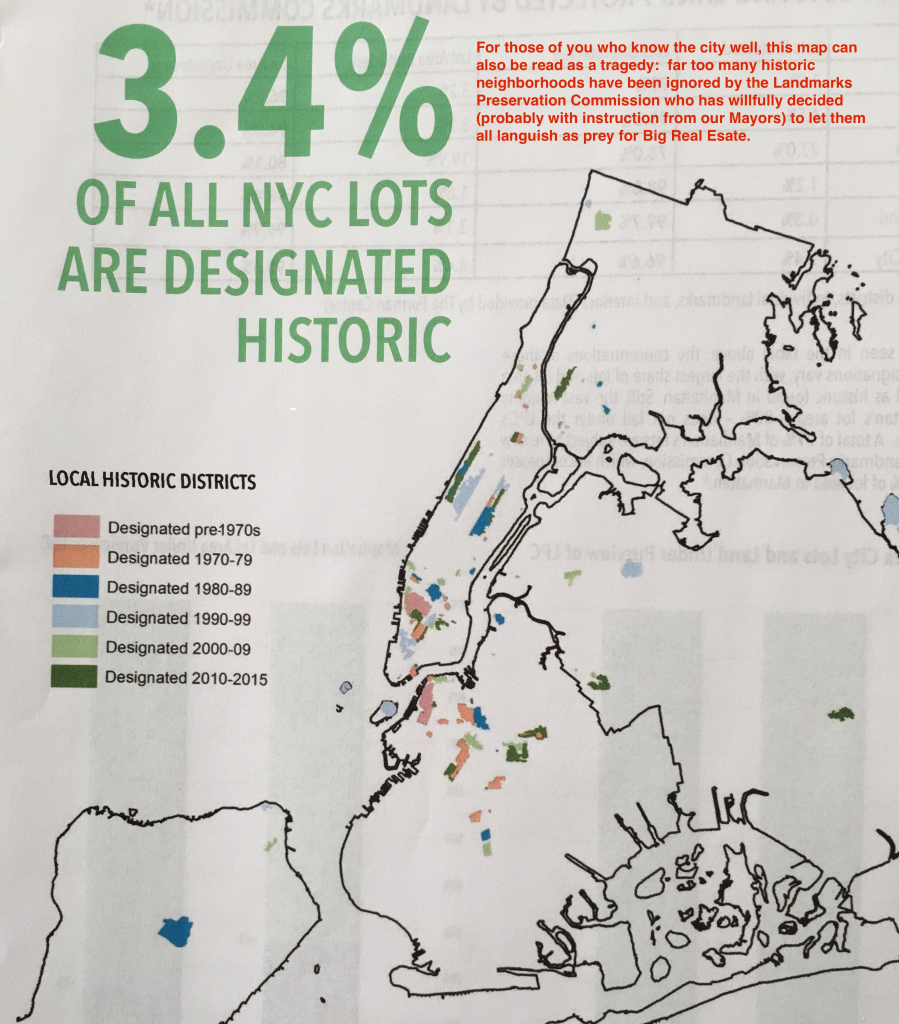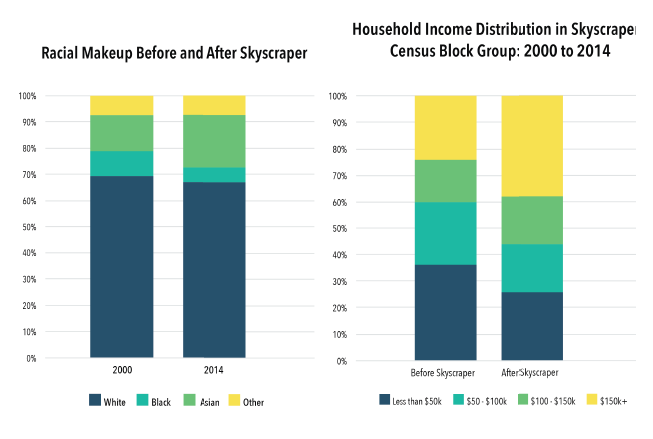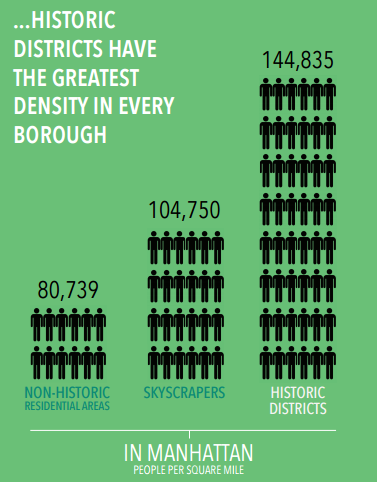A Crib Sheet to the Recent Study: HISTORIC PRESERVATION: AT THE CORE OF A DYNAMIC NEW YORK CITY
The above-mentioned study is not brand new, but it was under-reported last spring when the Landmarks Conservancy released it. That is to be lamented, as the study is of huge importance to our city. Shame on the mainstream press for not lapping it up.
We won’t ask you to wade through the whole report. Our gift to you is right here: a cheat sheet of the main findings. For those who want details, a link to it is at the bottom of this post.
Background

Photo Source: PlaceEconomics.com
Donovan Rypkema is the principal of PlaceEconomics, a real estate and economic development consulting firm focusing on historic preservation and economics. Rypkema has a long career in analyzing the economic benefits of historic preservation. He is the author of many reports and books, including The Economics of Historic Preservation: A Community Leader’s Guide. Rypkema is also a professor at the University of Pennsylvania’s Historic Preservation program. So is he a credible source? You bet.
Last year, New York Landmarks Conservancy hired PlaceEconomics to look at New York’s situation. The result: Historic Preservation: At the Core of a Dynamic New York City. The report was part of the 50th anniversary of New York City’s Landmarks Law.
The report also came at a significant moment. As you all know, Big Real Estate (aka, REBNY) has been ferocious in attacking historic preservation. Some of their weapons: the false premises that historic districts make the city unaffordable, create a lack of diversity, and impose high costs for developers. The new report studied and analyzed New York City’s situation in light of such arguments. It contradicts – with facts – Big Real Estate’s rhetorical weapons. That’s the good news. The bad news is that our politicians are not profiting from Rypkema’s report to defend neighborhoods. In the hope that our pols just need a cheat sheet to the main findings to do their job better, here goes…..
Arm Yourself Here: The 12 Most Important Findings

Report cover (Photo Source: New York Landmarks Conservatory)
1. “New York is the most competitive city today and will remain so in 2025.” declares Professor Rypkema, citing a report, “Benchmarking the future competitiveness of cities” produced by the Intelligence Unit of The Economist, 2013. – p. 3
- This means that Big Real Estate can stop whining that we are going to lose our ‘competitive edge’ if we don’t turn Midtown – or everywhere else – into Dubai or Shanghai.
2. Only 3.4% of the lot area in New York City is protected. Designated historic districts, individual landmarks, or interior landmarks cover a mere 4.4% of the City’s total lot area. Therefore, 95% of the City is not protected by New York City Landmarks. – p.4 See the great map below.
- This fact is a double-edged sword. Many neighborhoods in NYC merit historic district protections but their pleas for these have been ignored. Has our Landmarks Commission gone off-duty in the last couple of administrations and stopped designating anywhere that in in play among developers? And when they do designative, why are they so stingy and leaving out areas that developers complain should come down and be replaced by towers?
- The finding also implies that our politicians need to look elsewhere for their bogeyman about what is causing housing prices to rise. Aside: In Rypkema’s video debate with Edward Glaeser (on the Conservancy’s website) we learn that what really pisses off Big Real Estate is this: many of the historic districts are in prime locations in the historic core of New York City (where we would expect them to be from an architectural point of view). Darn it. That is exactly where Big Real Estate wants to put up luxury towers! Glaeser thinks that not an inch more of the city should be designated a historic district, and that developers should not touch the outer reaches of the city where the demand from luxury buyers falls off. He advocates instead that we rebuild Manhattan and desirable areas of Brooklyn and Queens into a New York version of Dubai’s tower-world.

(Map Source: page 5 of the report (red commentary on upper right of image is ours not Rypkema’s)
3. While only 4.4% of NYC’s lot area is protected by historic preservation designation, 2/3 of properties are zoned for one to two family houses. Rypkema concludes that blaming historic districts for high apartment prices makes no logical sense: “Based on the Real Estate Board of New York’s (REBNY) own calculations, low-density residential zoning is nearly 20 times the problem (if indeed it is a problem ) as are the historic districts.” – p. 7
4. Skyscrapers worsen gentrification and worsen the affordability crisis more than historic districts. New skyscrapers displaced mostly black households (replaced by Asian households). Skyscrapers also worsened the inequality in income distribution, with households earning more than $150,000 moving into new skyscrapers displacing all other income groups. This $150k + income group now shifted from 25% of the population to about 38% of the population. – p.16
- This is an amazing finding, Human-Scale City supporters. The implication is that to add housing and density to the city without the issue of displacement and hyper-gentrification, we don’t need to do it through skyscrapers or through the Mayor’s neighborhood-destroying “hyper-density” model. We’d be better off adding density through human-scale means.
 (Chart Source: page 16 of the report)
(Chart Source: page 16 of the report)
5. There has been steady growth in the production of housing units since the financial crisis. 2015 had a record number production of housing units with 36,850 units. 2016-2017 is expected to create another 57k housing units. – p. 7
- This means that there is no crisis of housing production so that the complaining of Big Real Estate that we are preventing developers from doing their thing (through over-regulation, for example) is just an alternative fact, or a “red herring” to mislead us.

(Chart source: page 18 of the report)
6. Historic districts are the densest neighborhoods in New York (144,835 people per square mile in Manhattan). This is denser than skyscrapers (104,750 per square mile) and non-historic district neighborhoods (80,739).
- This astonishing factoid speaks for itself.
7. Tiny historic districts are heavyweights in attracting jobs. Historic districts contain 8% of all private sector jobs, 9.9% of all NYC small firms, 10.1% of all startups, and 10.9% of jobs in young firms. – p. 23
8. Historic Districts have an outsized influence in creating our sense of great urbanity: 12% of all restaurant, cafes, hotel, and bar jobs are located in historic districts. Historic districts include 20% of jobs in arts, entertainment and recreation and more than 10% of professional, scientific, or technical jobs. – p. 29, 33
9. Historic Districts supports the construction industry – big time: about $865 million a year is spent on construction in NYC historic districts, which has created about 9,000 jobs. – p.25
10. Older (historic) buildings tend to be more energy efficient. Multi-family properties built since 1980 used nearly 13% more energy per square foot than did an apartment built before 1920. An office tower built after 1980 uses 33% more energy than one built nearly a century ago. – p.38-39

(Chart Source: page 39 of the report)
 11. People want to live in historic buildings. In their opinion survey, PlaceEconomics found that even though less than 10% of New Yorkers live in a historic district, over half WANT to live in one. When asked what type of housing, 1/3 of the responders selected single-family brownstone as their top choice of residence. On the other hand, new high-rises were ranked last in terms of personal preference as to where to live. – p.43-44. (Well, we can all dream can’t we?)
11. People want to live in historic buildings. In their opinion survey, PlaceEconomics found that even though less than 10% of New Yorkers live in a historic district, over half WANT to live in one. When asked what type of housing, 1/3 of the responders selected single-family brownstone as their top choice of residence. On the other hand, new high-rises were ranked last in terms of personal preference as to where to live. – p.43-44. (Well, we can all dream can’t we?)
12. NYC Landmarks Preservation Commission (LPC) approval isn’t as difficult as Big Real Estate says. In fact,. LPC approves nearly everything that comes its way: over the last 15 years, 86.7% of applications were approved, with only 3/10 of 1% getting denied. In addition, 95% of applications don’t even require you to appear at a hearing and are resolved at staff level. -p.49
- So much for the LPC being a regulatory burden to anyone. In fact, the pendulum may have swung too far in the direction of utter laxity.
Rypkema’s study sheds considerable light on the benefits and impacts of historic districts. Conversely, the report brings data forward about the negative effects of skyscrapers, which have disturbing statistics in regards to affordability, energy use, and diversity. Kudos to the Landmarks Conservancy for hiring Professor Rypkema and making policy wonks of us all.
(For those who want to get into the weeds of it, check out the abundantly illustrated full report on the New York Landmarks Conservatory’s website, here.) You’ll also find there a snippet of a video with Rypkema arguing (brilliantly) with our arch-enemy, Edward Glaeser, ideologue of the terrifying Dubai-on-Hudson vision of our future.

